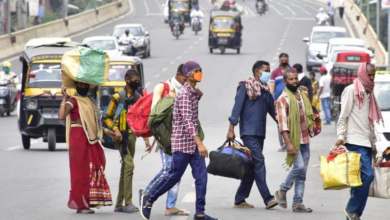India’s wheat export ban – a practical step to tame food inflation

Ratnajyoti Dutta
India’s latest move to ban wheat exports came as a surprise to all. The Prime Minister Narendra
Modi-led Government decided to go ahead with the wheat export ban after May 13 to tame high food inflation by ensuring domestic supplies
India, the world’s fastest-growing large economy, has been battling an eight-year high inflation level. The high retail inflation has been triggered by the high prices of farm commodities and transportation fuels caused by the Ukraine-Russia conflict.
Wheat, the main winter season food crop in India, faced record temperatures during the final maturing stage. The heat waves that blew over the growing areas cut the initial output projections for the temperature-sensitive crop.
India, the world’s second-biggest grain producer after China, grows wheat once a year from October to December, while the crop harvest takes place in March-April. The exact extent of the damage to the crop due to the heatwave conditions in the northwest region, the grain bowl of the country, was not known initially, as evident by the preliminary projection of wheat exports.
The farm ministry estimated India’s wheat output at 111 million tonnes in February, a record output for the sixth straight year. India produced a record 110 million tonnes in 2021. The record production expectation also led to a record export projection of 10 million tonnes in 2022.
In early May, the official estimate was scaled down by 5.4% to 105 million tonnes, an admission of the impact of the heatwave on the grain. The fear still persists that the wheat output estimate for 2022 could come down to below 100 million tonnes in the final estimate. A production level of less than 100 million tonnes would mean a production level for the first time in five years.

India has been battling with high inflation levels since the Russian invasion of Ukraine on February 24, primarily caused by higher global crude prices as a fallout of the conflict between the two European neighbors. India, the world’s third-biggest crude importer and consumer, meets around 85% of its domestic fuel demand via overseas purchases.
In March, global crude prices hit a 13-year high level at $139 per barrel due to the Ukraine-Russia conflict’s global supply concerns. The Modi-led Government was confident of a comfortable food supply situation until April, with a record export projection of wheat.
The food inflation index hit a new high of 8.9% in April. After taking a comprehensive view of the overall grain stock situation and the high food inflation level, the government decided to impose a ban on the overseas sale of wheat by private trade. But it kept open the export window for government-to-government deals.
Wheat exports will not be a record in 2022. Instead, overseas sales this year are expected to be far less than half of last year’s record level of 7 million tonnes. Besides, India maintains a buffer stock level for wheat and rice to meet any emergency demand situation, as happened during the coronavirus pandemic years.

The surprise ban on wheat exports during the second week of May caught exporters unaware, putting around 1.8 million tonnes of the grain stranded at various ports and warehouses due to the requirement of last-minute clearance on the line of credit for exports
India had supplied food to around 80 million people through welfare programmes during the challenging times of COVID-19 in 2020 and 2021. During the pandemic times, the Indian government ran the world’s largest food distribution network for the COVID-19 hit population, aided by the grain reserves in its kitty.
G7 reaction to ban
India’s move to ban wheat exports received mixed reactions from the rest of the world. The Group of Seven, popularly known as the G7, is a bloc of the developed nations. The block criticised India’s move to cut the supply of the grain into the world market by saying that if each country resorts to restricting supplies, then the world’s food supplies would be squeezed. The block criticised India’s decision to ban wheat exports, saying such a step would “worsen the crisis” of rising prices of farm commodities in the world.
“We have seen reports on India’s decision. We encourage countries not to restrict exports,” said Linda Thomas Greenfield, US ambassador to the United Nations.
Chinese support
India received a surprising response to the move to ban wheat exports from China, the world’s biggest grain producer. China endorsed India’s decision to ban wheat exports from ensuring domestic supplies. “Blaming India won’t solve the food problem,” said an editorial piece in the Global Times, a Chinese government media outlet, after India decided to ban wheat exports.
Instead, the dragon economy advised the block of developed nations to raise wheat export flows by its members into the world food market to ease any supply worries shortly. India has maintained a policy to uphold domestic food supplies as it has around one-third of its 1.3 billion population still living below the poverty line. India also kept the window of overseas sales open when the grain silos overflowed for the rest of the world.
Despite the latest ban on wheat exports, India has allowed wheat exports to friendly countries like Egypt on Government-to-Government deals. Indian wheat export deals struck until May 13 by private trade to countries such as Brazil, Bangladesh, Oman, and Indonesia have been permitted for shipment. Trade estimates put India’s wheat export volumes at around 1.5 million tonnes before the ban was imposed.
Export ban validity
The ban on wheat exports is expected to continue until the end of the current fiscal year in March 2023, when the new wheat crop will hit in markets. The expectation of the lifting of the existing ban after the following year’s harvest season is based on a presumption of ease in the high fuel price-induced inflation levels and a higher
output of the wheat crop.
The surprise ban on wheat exports during the second week of May caught exporters unaware, putting around 1.8 million tonnes of the grain stranded at various ports and warehouses due to the requirement of last-minute clearance on the line of credit for exports.
Pragmatic move
Experts termed the decision to ban wheat exports against the backdrop of lower output projections and ongoing high food inflation as “a pragmatic step” to control prices by removing any market perception of a shortage. “We are committed to our mandate to ensure food supplies to common people at affordable prices,” said a senior member of the Modi-led cabinet who did not wish to be named.
(The writer is a renowned Delhi-based international journalist.)
Credit : The article was first published at Organiser online on May 24, 2022.
Photo Source : Internet






